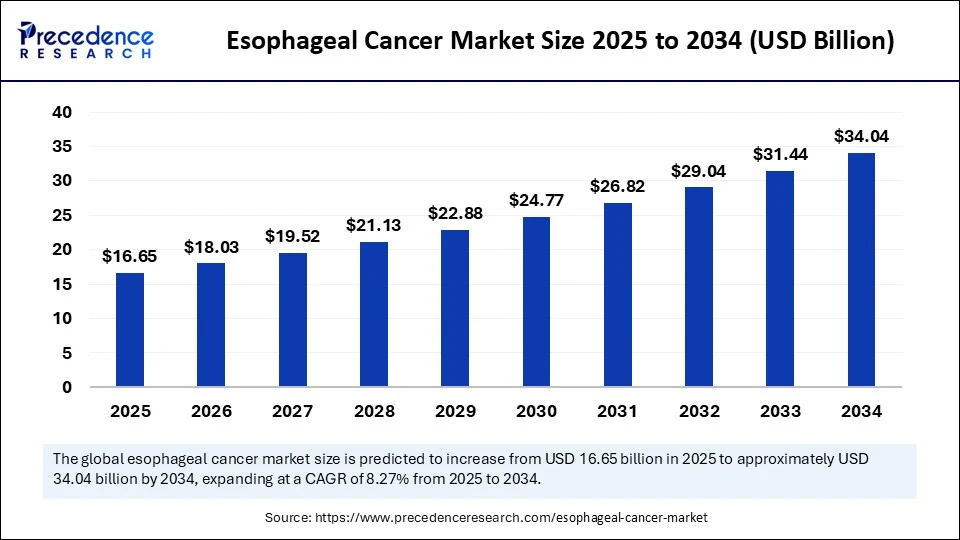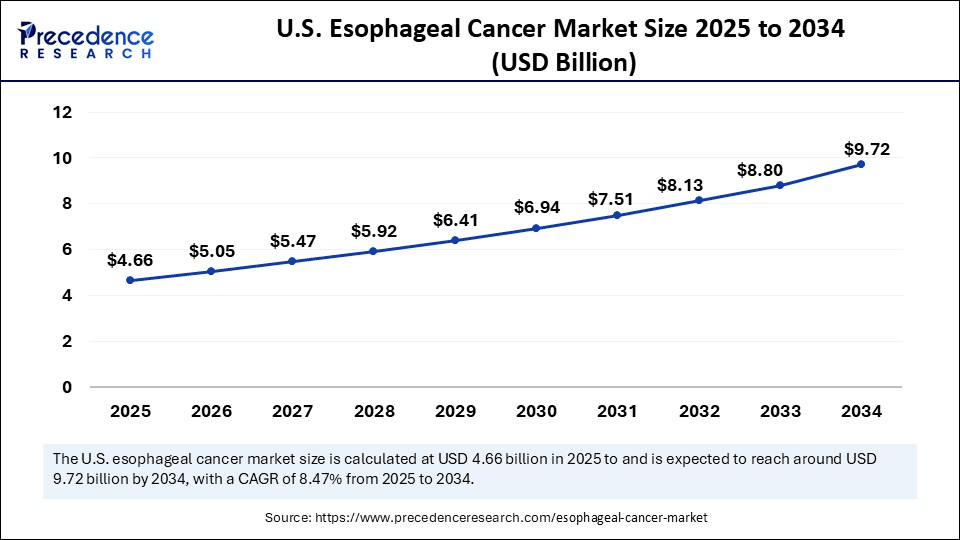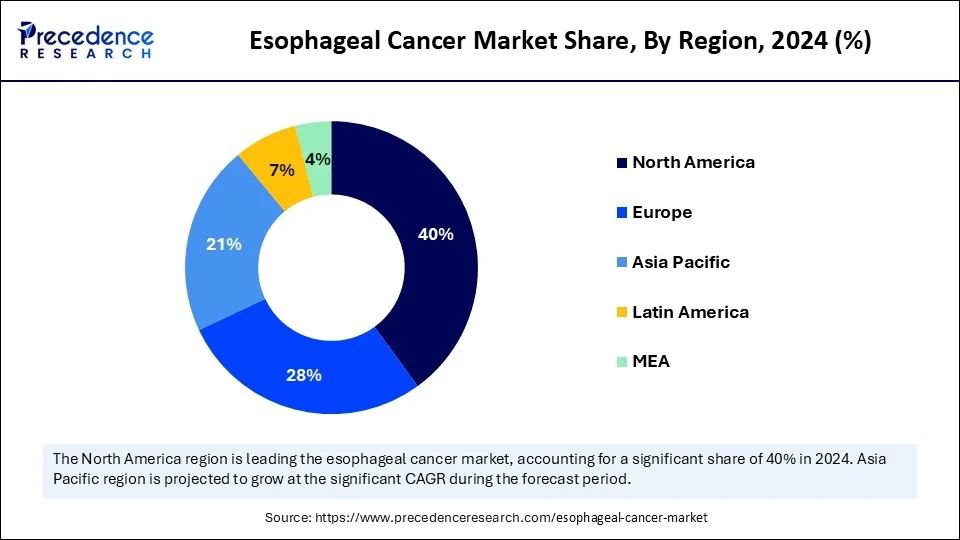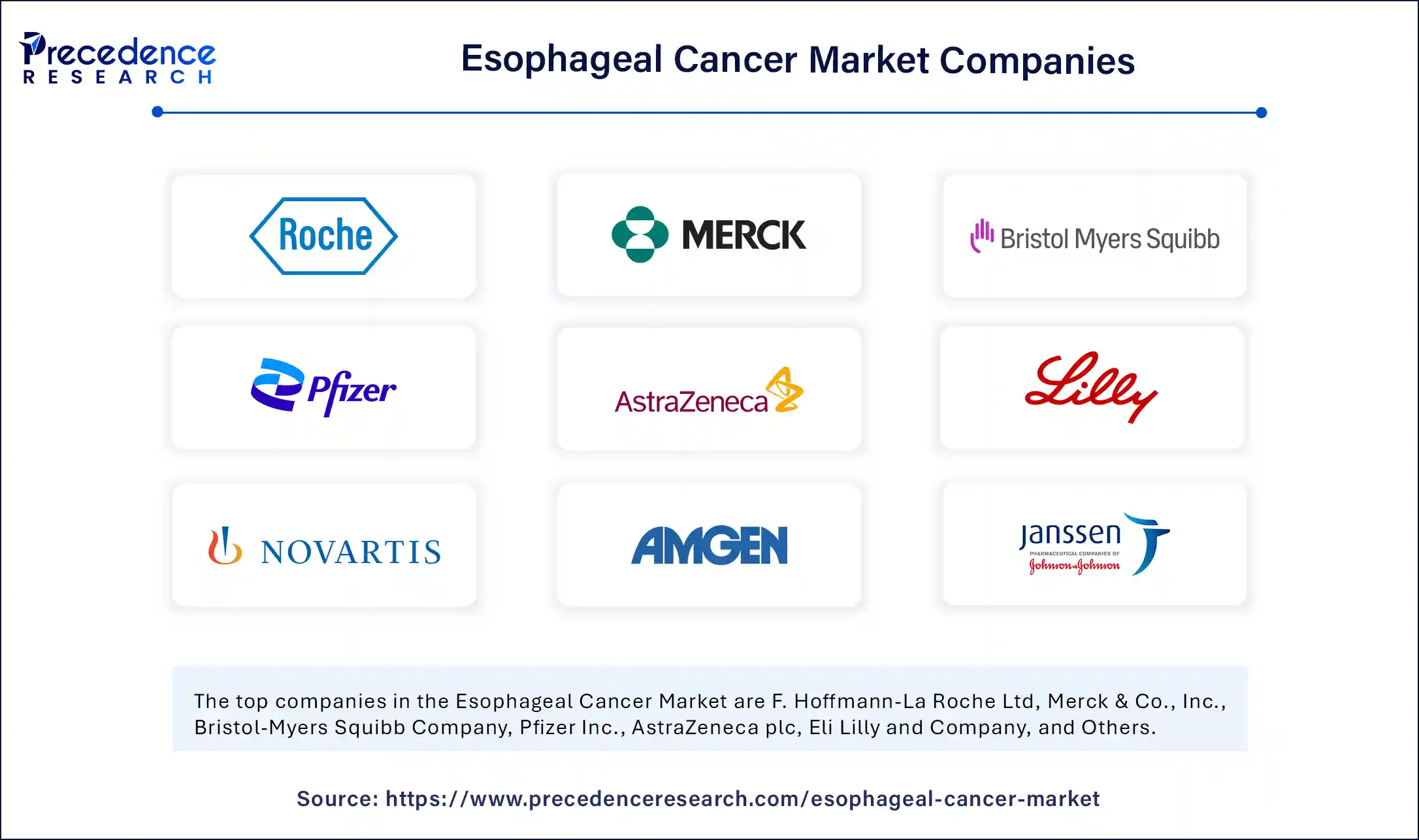Esophageal Cancer Market Size and Forecast 2025 to 2034
The global esophageal cancer market size accounted for USD 15.38 billion in 2024 and is predicted to increase from USD 16.65 billion in 2025 to approximately USD 34.04 billion by 2034, expanding at a CAGR of 8.27% from 2025 to 2034. The growth of the esophageal cancer market is driven by increasing disease prevalence around the world, an aging population, the development of advanced diagnostic tools, and demand for targeted therapies.

Esophageal Cancer MarketKey Takeaways
- In terms of revenue, the global esophageal cancer market was valued at USD 15.38 billion in 2024.
- It is projected to reach USD 34.04 billion by 2034.
- The market is expected to grow at a CAGR of 8.27% from 2025 to 2034.
- North America dominated the esophageal cancer market with the largest market share of 40% in 2024.
- Asia Pacific is expected to witness the fastest growth during the forecast years.
- By cancer type, the squamous cell carcinoma segment led the market with the biggest market share of 80% in 2024.
- By cancer type, the adenocarcinoma segment is anticipated to show considerable growth over the forecast period.
- By diagnosis, the endoscopy segment held the significant market share of 40% in 2024.
- By diagnosis, the imaging segment is anticipated to show considerable growth over the forecast period.
- By treatment, the therapy type segment generated the highest market share of 60% in 2024.
- By stage, the stage II segment captured the remarkable market share of 35% in 2024.
- By route of administration, the intravenous segment contributed the biggest market share of 85% in 2024.
- By route of administration, the oral segment is anticipated to show notable growth during the forecast period.
- By end user, the hospitals segment accounted for major market share of 70% in 2024.
- By end user, the ambulatory surgical centers segment is anticipated to show considerable growth over the forecast period.
- By distribution channel, the hospital pharmacies segment led the market with a biggest market share 60% in 2024.
- By distribution channel, the online pharmacies segment is anticipated to show considerable growth over the forecast period.
How is AI Transforming the Diagnosis of Esophageal Cancer?
Artificial intelligence is transforming the esophageal cancer market by improving identification and management. AI analyzes vast data, including medical history and imaging results, to identify high-risk individuals. AI-assisted systems detect anomalies, like precancerous lesions, with greater accuracy, enabling earlier treatment and improved outcomes. Moreover, AI accelerates the drug discovery process by identifying potential drug targets, predicting drug efficacy, and optimizing clinical trial designs. This reduces the time and cost associated with bringing new therapies to market, expanding treatment options.
U.S. Esophageal Cancer Market Size and Growth 2025 to 2034
The U.S. esophageal cancer market size was exhibited at USD 4.31 billion in 2024 and is projected to be worth around USD 9.72 billion by 2034, growing at a CAGR of 8.47% from 2025 to 2034.

What Made North America the Dominant Region in the Esophageal Cancer Market in 2024?
North America registered dominance in the market with a major revenue share in 2024. This is mainly due to the increased incidence of esophageal cancer and well-established healthcare systems. There is high adoption of advanced diagnostic technologies, including high-resolution endoscopy, molecular imaging, and AI-based diagnostic tools, leading to increased diagnostic. This further prompted the need for novel therapeutics. O a significant improvement in the quality of early diagnosis in the region. The market has also been positively influenced by government initiatives that promote early cancer screening and increase disease awareness.
The U.S. plays a major role in the market, holding the majority of the share in 2024. The U.S. market benefits from comprehensive insurance coverage, strong reimbursement systems, and collaborative partnerships between academia, biotech firms, and clinical trial groups. There is heightened awareness of health and wellness and improved access to superior care, supporting market growth.

Why is Asia Pacific Expected to Witness the Fastest Growth in the Esophageal Cancer Market?
Asia Pacific is expected to grow at the fastest CAGR during the forecast period. The growth of the market is supported by the expansion of oncological research infrastructure and health initiatives by governments that focus on early detection and intervention strategies. The rising healthcare policies, enhancing access to medications, and rising development of novel treatments are shaping the future of the esophageal cancer market. China is a leading player in the esophageal cancer market within Asia Pacific. There is a high availability of affordable medicines. Robust pharmaceutical manufacturing sector and rising investments in cancer research are fostering innovation in the market. With heightened awareness and international collaborations with medical institutions, there is a concurrent rise in access to more advanced diagnostic and therapeutic options.
What Opportunities Exists in the European Esophageal Cancer Market?
Europe is considered to be a significantly growing area. The market within the region is expected to grow due to its well-developed healthcare systems, focusing on early screening and specialized cancer treatment. There is rising demand for advanced treatments as a result of increased cancer burden. Moreover, increased access to innovative treatment approaches, including immunotherapies and targeted therapies, is improving treatment outcomes and expanding patient treatment choices. Germany is a major player due to its highly developed healthcare system, high diagnosis rates, and significant investments in cancer research.
Market Overview
The esophageal cancer Market refers to the global ecosystem of products, services, technologies, and stakeholders involved in the prevention, diagnosis, treatment, and management of esophageal cancer, a malignancy affecting the esophagus. This market encompasses pharmaceuticals (chemotherapy, targeted therapy, and immunotherapy), diagnostics (biopsies, imaging), surgical and non-surgical treatments, and supportive care. The growth of this market is driven by increasing incidence rates, advancements in targeted therapies and immuno-oncology, and evolving diagnostic technologies.
The market is set to expand rapidly due to the rising number of cases of esophageal cancer, increased awareness, and technological advancements in diagnostics and treatments. Factors like an aging population, smoking, alcohol consumption, obesity, and Barrett's esophagus contribute to this growth. Increased investment in cancer research by pharmaceutical companies and healthcare expansion in new markets further improve treatment access and drive market growth.
What Factors are Fueling the Growth of the Esophageal Cancer Market?
- Aging population and Increase in Incidence: The market is growing substantially due to rising global incidence of esophageal cancer, particularly among the aging population. Increased patient numbers and risk factors like smoking, alcohol use, and poor diet boost demand for diagnostics, therapies, and advanced treatments in both developed and developing healthcare sectors.
- Targeted Therapies and Immunotherapies Development: The development of newer, more personalized medicines is transforming the esophageal cancer treatment approaches with targeted therapies and immunotherapies such as the PD-1/PD-L1 inhibitors. Expanding treatment options leads to increased adoption and investment in novel treatments. Rising FDA approvals for new therapeutics and active clinical trials are driving the market growth.
- Rising Health Awareness and Screening Strategies: Public health campaigns and screening programs by government agencies are boosting awareness, leading to increased demand for early diagnosis of esophageal cancer. Symptom-specific and risk factor-specific campaigns are increasing diagnosis rates.
Market Scope
| Report Coverage | Details |
| Market Size by 2034 | USD 34.04 Billion |
| Market Size in 2025 | USD 16.65 Billion |
| Market Size in 2024 | USD 15.38 Billion |
| Market Growth Rate from 2025 to 2034 | CAGR of 8.27% |
| Dominating Region | North America |
| Fastest Growing Region | Asia Pacific |
| Base Year | 2024 |
| Forecast Period | 2025 to 2034 |
| Segments Covered | Cancer Type, Diagnosis, Treatment, Stage, Route of Administration, End User, Distribution Channel and Region |
| Regions Covered | North America, Europe, Asia-Pacific, Latin America, and Middle East & Africa |
Market Dynamics
Drivers
Growing Disease Incidence and Improved Treatment Accessibility
The prevalence of esophageal cancer has increased worldwide, driven by several risk factors, which include smoking, excessive drinking, poor diet, and the widespread occurrence of gastroesophageal reflux disease (GERD). According to the National Agency for Research on Cancer, in 2020 there were estimated to be about 604,000 new cases of esophageal cancer and about 544,000 deaths from esophageal cancer globally, with large variations in incidence and mortality across world regions. The highest incidence rates were observed in Eastern Asia and Southern and Eastern Africa. This significantly prompted the need for better screening and action strategies. Since people have become more aware of the importance and benefits of early diagnosis, there is an increasing investment in this area. Governments and healthcare organizations around the world are responding by implementing endoscopic screening programs and improved diagnostic technology. The increased need for early diagnosis leads to the demand for new diagnostic methods and less invasive procedures, boosting the growth of the market.
(Source: https://www.iarc.who.int)
Restraint
High Treatment Costs and Limited Access to Early Diagnosis
The high costs associated with novel treatments, especially immunotherapies and biologics, are major factors restraining the growth of the esophageal cancer market. These treatments are costly, creating barriers for potential patients particularly in low- and middle-income countries. The economic factor is a major obstacle for pharmaceutical companies and healthcare providers. Limited early screening and diagnostic programs, especially in rural and underserved areas, also restrain the market. The lack of early diagnosis leads to later-stage diagnoses, reducing treatment effectiveness and survival rates. Moreover, the complexity of esophageal cancer treatment, requiring multidisciplinary approaches and specialized expertise, poses challenges for healthcare providers.
Opportunity
Enhanced Convenience through Advanced Diagnostic and Treatment Technologies
A major opportunity for the esophageal cancer market lies in the rapid advancements in diagnostic technologies, contributing to early diagnosis and patient comfort. Minimally invasive procedures, like advanced endoscopy integrated with biomarker-based detection, help clinicians detect esophageal cancer earlier and precisely. Prompt diagnosis improves treatment outcomes and patient survival. A combined diagnostic stage evaluates tumor location, condition stage, and molecular features, aiding in treatment selection and personalized medicine. In addition, the rising development of personalized medicine creates immense opportunities in the market. Developing personalized medicine approaches, including biomarker-driven therapies and tailored treatment plans, can improve treatment efficacy and patient outcomes.
Cancer Type Insights
Why Did the Squamous Cell Carcinoma Segment Dominate the Esophageal Cancer Market in 2024?
The squamous cell carcinoma segment dominated the market with a 80% share in 2024. Squamous cell carcinoma (SCC) develops in the squamous cells that line the upper and middle esophagus and is closely associated with the risk factors like tobacco consumption, excessive consumption of alcohol, and nutritional deficiencies. SCC is often diagnosed at the late stage due to atypical early symptoms, leading to a poor prognosis and a need for effective treatments. Ongoing research targeting SCC-specific pathways and novel treatment modalities drives investment and segmental expansion.
The adenocarcinoma segment is expected to grow at the fastest CAGR over the forecast period. Adenocarcinoma of the esophagus typically develops in the glandular cells of the lower esophagus, at the junction with the stomach, and is largely connected to risk factors such as obesity, gastroesophageal reflux disease, and Barrett's esophagus, a known precursor disorder. Due to the increasing rates of obesity and chronic GERD, cases of adenocarcinoma have been on the rise. The rising development of novel detection tools, including screening for Barrett's esophagus, is leading to increased diagnostic rates. This significantly increases the demand for more effective and accurate therapies, including immunotherapies and molecularly targeted drugs.
Diagnosis Insights
How Does the Endoscopy Segment Dominate the Market in 2024?
The endoscopy segment dominated the esophageal cancer market with a 40% of share in 2024. Endoscopy is the gold standard diagnostic tool because flexible endoscopes are widely available in healthcare facilities worldwide. Besides diagnosis, endoscopy is also used for treatment, including endoscopic mucosal resection (EMR) and ablation techniques, increasingly used to treat early-stage esophageal cancer and precancerous lesions like Barrett's esophagus. Due to increased awareness and screening programs for esophageal cancer, the demand for endoscopic procedures is projected to remain high, continuing its dominance in the market.
The imaging (CT, PET, MRI) segment is expected to grow at the highest CAGR during the projection period. The growth of the segment is attributed to the increasing need for early disease detection. In esophageal cancer, imaging modalities are crucial for staging, treatment planning, and monitoring treatment response. CT scans provide detailed cross-sectional views of the chest and abdomen, allowing for measurements of tumor size, local infiltration, and lymph node involvement. PET scans are valuable for detecting metabolically active cancer cells, which aids in identifying distant metastases and guiding treatment decisions. Ongoing advancements in imaging technology are enhancing diagnostic accuracy.
Treatment Insights
What Made Therapy Type the Most Preferred Approach for Esophageal Cancer Treatment?

The therapy type segment led the esophageal cancer market with the largest share of 60% in 2024, as therapies like chemotherapy, radiation therapy, and combined chemoradiation remain the staple treatments of cancer. Therapeutic approaches are tailored to the cancer stage, histological subtype (adenocarcinoma or squamous cell carcinoma), and the patient's overall condition. They are also applied in cases of recurrence or metastatic diseases when conventional treatments are less effective. The development of new agents and combination regimens is increasing, which can address unmet medical needs. In addition, the rising demand for targeted therapies is likely to ensure the long-term growth of the market.
Stage Insights
Why Did the Stage II Segment Dominate the Market in 2024?
The stage II segment led the market with a 35% share in 2024. Stage II means that the cancer has invaded through the muscle and connective tissue around the esophagus and has possibly spread to local lymph nodes. Stage II esophageal cancer is further divided into IIA and IIB based on tumor size, lymph node involvement, and grade. Stage II disease is typically treated with chemotherapy or radiation therapy, often in combination, to reduce tumor burden and improve surgical outcomes. Early intervention in this stage leads to a better prognosis, driving the demand for effective therapeutic regimens.
Route of Administration Insights
How Does the Intravenous Segment Led the Esophageal Cancer Market?
The intravenous (IV) segment led the market with a 85% share in 2024. This is mainly due to the increased demand for targeted therapies. The rapid onset of action of IV therapies enhance patient outcomes. Many chemotherapy and immunotherapies are administered via IV injection, ensuring rapid and controlled entry of the medicine into the bloodstream and full distribution throughout the body. IV therapy can be used alone or with other treatments like surgery and radiation, forming part of multimodal therapy. It offers a clinical advantage due to the controlled medication dosage and the ability to use drugs that cannot be taken orally, especially for aggressive or end-stage cancers.
The oral segment is expected to grow at the fastest rate during the forecast period. Oral medications, particularly targeted therapies and chemotherapeutic agents, offer patients the convenience of self-administration at home. This is especially appealing in maintenance therapy and early cancer management, where intermittent treatment over a long period is needed. Advancements in pharmaceutical innovation have led to tge development of more effective oral medications with higher bioavailability and tolerability, increasing their use in esophageal cancer treatment.
End User Insights
What Made Hospitals the Prominent End-user?
The hospitals segment dominated the esophageal cancer market with a 70% share in 2024. Hospitals are equipped with multidisciplinary oncology care, advanced technology, and the resources to manage complex cases and provide end-stage treatment. They facilitate advanced surgeries like esophagectomies, which often require close post-operative care, solidifying their role as primary treatment centers. Hospitals also conduct clinical research and trials, fostering innovations in esophageal cancer treatment.
The ambulatory surgical centers segment is expected to grow at a significant rate in the upcoming period. The growth of the segment is attributed to the increasing demand for cost-effective treatments. ASCs offer a convenient and less expensive option for treating esophageal cancer, especially in its early stages and for precancerous lesions like Barrett's esophagus. Procedures such as endoscopic mucosal resection (EMR) and minimally invasive esophagectomy (MIE), which have shorter recovery times and require less intensive monitoring, are well-suited for ambulatory settings. The increasing use of advanced endoscopies and laparoscopies is expanding the range of esophageal cancer procedures safely performed in these centers.
Distribution Channel Insights
Why Did the Hospital Pharmacies Segment Dominate the Market in 2024?
The hospital pharmacies segment dominated the esophageal cancer market with a 60% share in 2024. This is mainly due to the increased patient volumes in hospitals, leading to a heightened demand for centralized purchase and distribution of expensive oncology drugs within institutional settings, such as hospitals and specialty centers. These environments offer benefits like high-quality assurance, advanced chemotherapy and targeted treatment management, and robust clinical oversight, ensuring safe and efficient medication use. Hospital pharmacies are crucial in clinical trials, managing investigational drugs and supporting the supply chain of innovative medications.
The online pharmacies segment is expected to grow at the rapid pace over the studied period. This is mainly due to the increasing need to reduce requent hospital visits. Online pharmacies offer patients a convenient way to order prescriptions from the comfort of their homes. They provide easy access to medications, including specialty drugs, which can be crucial for cancer treatment. The rise of digital health and e-commerce has made online pharmacies more accessible and user-friendly. These pharmacies provide doorstep delivery, eliminating the need to visit physical pharmacies and attracting more patients.
Recent Developments
- In June 2025, Tevimbra (tislelizumab), a drug therapy of lung and esophageal cancer, a product of immuno-oncology treatment of Glenmark Pharmaceuticals Ltd, a research based and a global pharmaceutical company based in India was launched when the drug got approval by the Central Drugs Standard Control Organization (CDSCO).
- In June 2025, Lucid Diagnostics Inc., a cancer prevention medical diagnostics firm at the commercial-stage and a fully owned subsidiary of PAVmed Inc., stated that Hoag has been granted a program of esophageal precancer integration that integrates the care areas like diagnostics, treatment, education, and prevention.
- In May 2024, Bristol-Myers Squibb Company reported encouraging outcomes of Phase III clinical studies of its immune checkpoint inhibitor drug nivolumab combined with chemotherapy in advanced esophageal squamous cell carcinoma therapy. The improvement in the overall and progression-free survival supports the use of immunotherapy in first-line treatment and boosts the interest of the company in innovative oncology treatments.
(Source: https://www.pharmabiz.com)
(Source: https://www.prnewswire.com)
(Source: https://news.bms.com)
Esophageal Cancer Market Companies

- F. Hoffmann-La Roche Ltd
- Merck & Co., Inc.
- Bristol-Myers Squibb Company
- Pfizer Inc.
- AstraZeneca plc
- Eli Lilly and Company
- Novartis AG
- Amgen Inc.
- Johnson & Johnson (Janssen Biotech)
- Daiichi Sankyo Company, Limited
- GlaxoSmithKline plc (GSK)
- Bayer AG
- AbbVie Inc.
- Takeda Pharmaceutical Company Limited
- Illumina, Inc. (diagnostics)
- Thermo Fisher Scientific Inc. (diagnostics)
Segments Covered in the Report
By Cancer Type
- Adenocarcinoma
- Squamous Cell Carcinoma
- Others (e.g., small cell carcinoma)
By Diagnosis
- Endoscopy
- Biopsy
- Barium Swallow (Esophagram)
- Imaging (CT, PET, MRI)
- Esophageal Manometry
- Blood Tests
By Treatment
- Therapy Type
- Chemotherapy
- Radiation Therapy
- Targeted Therapy
- Immunotherapy (e.g., checkpoint inhibitors)
- Surgery
- Endoscopic Treatments (e.g., mucosal resection)
- Palliative Care
- Drug Class
- PD-1/PD-L1 Inhibitors
- HER2 Inhibitors
- VEGF Inhibitors
- Cytotoxic Agents
- Tyrosine Kinase Inhibitors (TKIs)
- Antimetabolites
- Others
By Stage
- Stage 0 (Carcinoma in situ)
- Stage I
- Stage II
- Stage III
- Stage IV (Metastatic)
By Route of Administration
- Oral
- Intravenous
- Others
By End User
- Hospitals
- Specialty Cancer Centers
- Academic & Research Institutes
- Ambulatory Surgical Centers (ASCs)
- Homecare Settings
By Distribution Channel
- Hospital Pharmacies
- Retail Pharmacies
- Online Pharmacies
By Region
- North America
- Europe
- Asia Pacific
- MEA
- South America
For inquiries regarding discounts, bulk purchases, or customization requests, please contact us at sales@precedenceresearch.com
Frequently Asked Questions
Ask For Sample
No cookie-cutter, only authentic analysis – take the 1st step to become a Precedence Research client
 sales@precedenceresearch.com
sales@precedenceresearch.com
 +1 804-441-9344
+1 804-441-9344